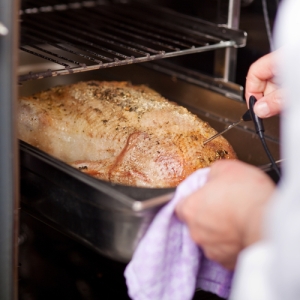American consumers are becoming more and more concerned with where their food comes from, how it is prepared and whether or not it is actually safe to eat. Allay any food safety fears your customers may have by following these food safety tips:
Shift mana gers, general managers and staff must have proper food safety knowledge because the health inspector will ask questions, and a restaurant can be fined for showing inadequate knowledge of safe food handling practices. There are several options available to have staff certified in food safety.
gers, general managers and staff must have proper food safety knowledge because the health inspector will ask questions, and a restaurant can be fined for showing inadequate knowledge of safe food handling practices. There are several options available to have staff certified in food safety.
One of the main culprits of foodborne illnesses is person-to-person contact resulting from dirty employee hands. Restaurant employees must regularly and thoroughly wash their hands in order to protect customers and the restaurant from a food poisoning outbreak.
Fresh produce is not always cooked before serving, so washing by hand is the only way to remove any bacteria that may be on the surface.
Refrigerators must maintain a temperature at or below 40 °F to minimize bacterial growth. Also, refrigerated foods can only be stored for a certain amount of time before they start to go bad.
 5. Cook foods to appropriate temperatures.
5. Cook foods to appropriate temperatures.In order to kill any bacteria present, foods must be cooked to a minimum internal temperature and sustain that temperature for at least 15 seconds.
Countertops, cutting boards, utensils, pots and pans and employee’s hands are all food contact surfaces that must be cleaned and sanitized before and after they touch food items.
Walking through your establishment once or twice a month will help you identify any potential food safety concerns. You can download a self-health inspection form or ask your health inspector for some of their forms, so you know exactly what areas pose the greatest risk.
State and county health departments are the direct enforcers of local, state and federal health regulations. When opening or operating a commercial kitchen, it is important to know the local health codes to avoid fines and prevent foodborne illness outbreaks.
 9. Regularly check temperatures.
9. Regularly check temperatures.Food either in commercial refrigeration or warming and holding equipment needs to be checked every two hours to assure that it is not in the food Danger Zone. It is sufficient to just check the equipment thermometer on refrigerated foods to assure that they are within safe levels. But for prepared foods, like soups and buffet items, it is necessary to check the food’s internal temperature to assure that it is above 140 °F.
Food can be contaminated anywhere along the supply chain, so it is important that food service operators purchase foods from approved sources and know when to accept or reject fresh meat, poultry and seafood.
| The above is an excerpt from the article, “Top Ten Safety Tips for the Restaurant Employee” For more info, please visit www.foodservicewarehouse.com. |


